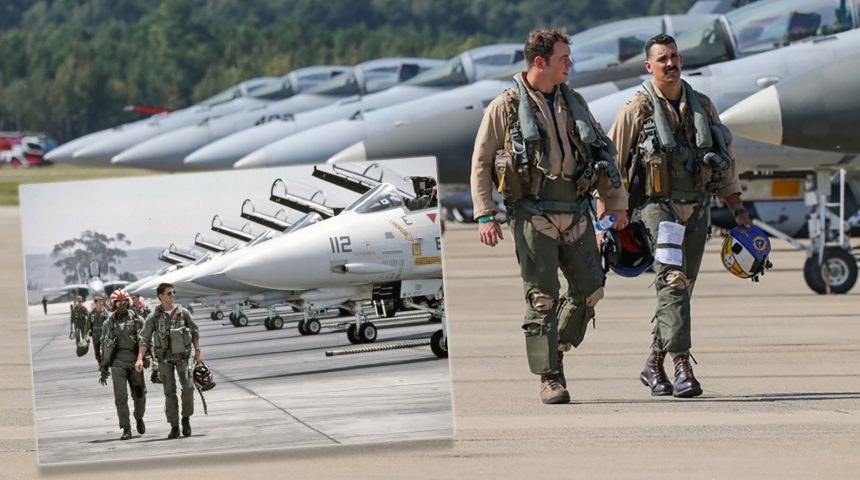“Top Gun” Movie Imagery Remains Timeless Among Elite Navy Fighter Pilots.
The 1986 film “Top Gun” is filled with iconic Hollywood scenes of Navy combat pilots. But how real are the images? How much does Hollywood’s iconic dramatization of Navy fighter pilots resemble modern day Naval combat aviators?
“I think every aviation fan loves those flight line scenes from “Top Gun”. I wanted to show how the mission of modern U.S. Navy fighter pilots is actually more like the iconic ‘Top Gun’ film than many people think,” The Aviationist’s Tom Demerly said.
Demerly, our U.S. correspondent, traveled to Naval Air Station Oceana in Virginia Beach, Virginia to try to reproduce an iconic Hollywood moment from director Tony Scott’s 1986 smash hit, “Top Gun” using real fighter pilots in their normal roles as Naval aviators training to fly from aircraft carriers near conflict zones around the world.
“A key thing was I didn’t want to pose the photo. I wanted it to be real. I wanted it to show Navy fighter pilots doing what they do in their real-world jobs.”
Demerly searched for photos of the flight line at Naval Air Station Oceana and compared them to stills from “Top Gun”. “It looked like there was a place where they may have parked enough aircraft in a row that the image could be duplicated. I needed a base that did not have the overhead sun shade structures you see at places like Davis-Monthan AFB.” He also used Google Earth to find the best location for the photo shoot.
Once a spot resembling the scene was found, Demerly traveled to the NAS Oceana Air Show to try to reproduce the image. “Oceana was having its annual air show and this was the perfect time to try to make the photo happen. I worked with the Navy Public Affairs Office at NAS Oceana to gain access to the flight line, a place normally restricted from photographers. Thankfully they were having their air show so they were willing to grant access for the project.”
Demerly found a row of U.S. Navy Boeing F/A-18A, B and D, and E and F Super Hornets parked closely and resembling the flight line at the former NAS Miramar, where some scenes from “Top Gun” were filmed.
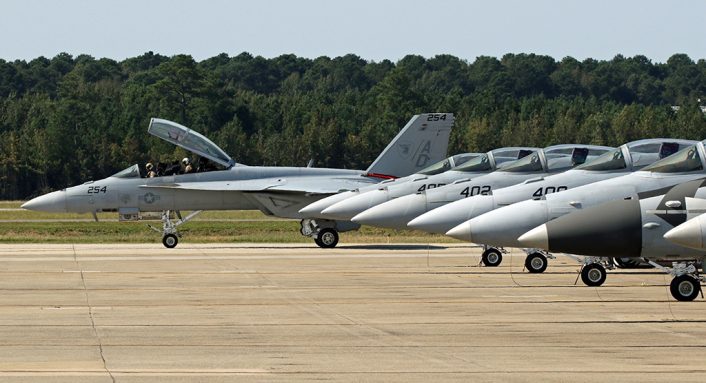
Even though Demerly is traveling this week from the NAS Oceana Air Show directly to MCAS Miramar for another media event, he knew it was less possible to reproduce the “Top Gun” flight line scene where it was originally shot at Miramar. “In 1993, seven years after ‘Top Gun’ was filmed there, NAS Miramar became Marine Corps Air Station Miramar and the mission and appearance of the base changed.”
Ten years after the filming of “Top Gun”, the Naval Fighter Weapons School, the formal name for the Navy’s TOPGUN school (only the movie title is separated into two words, the official name of the school is one word, customarily written in all capital letters), moved to the Naval Strike and Air Warfare Center at NAS Fallon in Nevada. This made reproducing the flight line scene at Miramar, where it was originally shot, much more difficult.
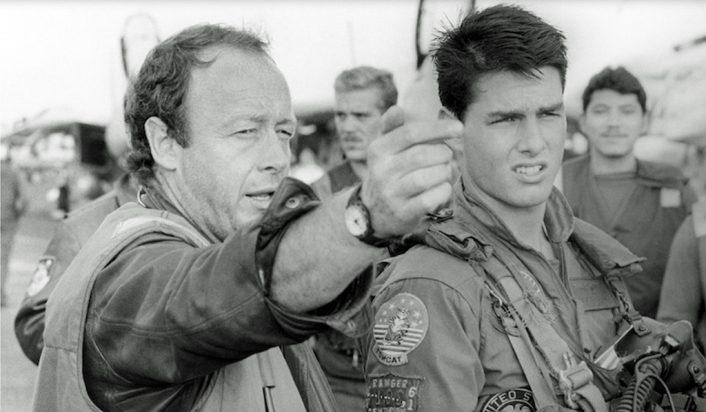
“Ultimately, I picked NAS Oceana for the photo shoot because the Public Affairs Office there was very supportive, the air show was happening and the images on Google Earth suggested it may work there,” Demerly said. “All I needed were the right two pilots and good timing.”
On the day of the photo shoot, Demerly found the location at NAS Oceana he had seen on Google Earth that resembled the set from the former-NAS Miramar “Top Gun” flight line scenes.
“It looked perfect. The original still photos from the movie I had on my iPhone showed seven F-14 Tomcats lined up. I found a spot at NAS Oceana with eight F/A-18 Hornets and Super Hornets lined up identically. Even the lighting was the same. From the front, the Hornet and Super Hornet look almost identical, so the shot had the visual similarity I was looking for.”
Once the location, aircraft and lighting were in place Demerly had to wait over three hours for the right shot to develop. “It was getting a little uncomfortable standing there on the tarmac for three hours. It was hot that day, and I was directly in the sun waiting for aircraft to taxi back in from a flight demonstration. I couldn’t leave because I may miss the shot. It could develop in just a few seconds when an aircrew returned and all of the ground crew were out of the shot.”
It the normal, real-world traffic on the flight line at NAS Oceana that made getting the photo just right so tricky.
“That was tough. The flight line at NAS Oceana during an airshow is a very busy place. There were tons of ground crew on the flight line between the aircraft, there was equipment parked out there. It was just a normal, busy, working Naval aviation flight line. It wasn’t a Hollywood movie set. It was much more crowded, much busier looking.”
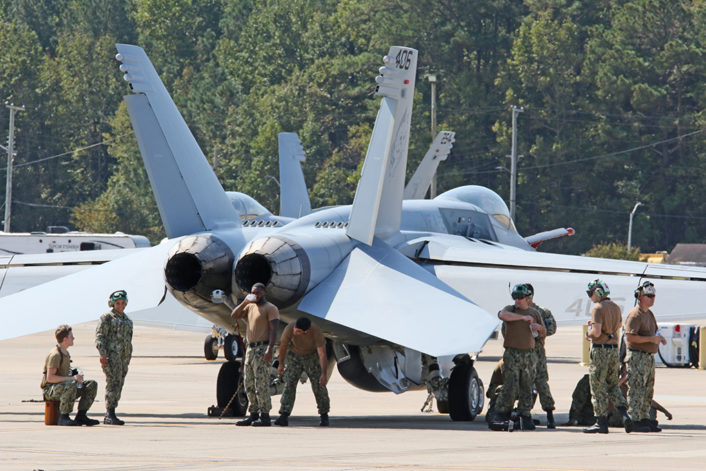
Finally, a Boeing F/A-18F Super Hornet from one of the flight demonstrations taxied in and parked. The aircraft lined up opposite where the photo needed to be shot, so Demerly needed the crew to walk across from their aircraft to another row of aircraft to get the same look as the movie scene. And then it got more complicated.

“In addition to ground crew and service vehicles, the families of some of the aircrews came on the flight line for a photo opportunity with their relatives were pilots. The whole scene got very, very crowded for a few minutes. With all those people walking on the flight line in front of the aircraft I started to think this was not going to happen.”
Demerly used a 150-600mm zoom lens for the shot. “I wanted the focal length and depth of field to look like the movie. Another problem was the angle of the movie shot. It looks like the original flight line scene was shot from an elevated angle on a camera boom. I couldn’t get that same elevation for my shot, but I could get the about the same angle of view on the aircraft and similar lighting and depth of field, so that’s what I went for.”
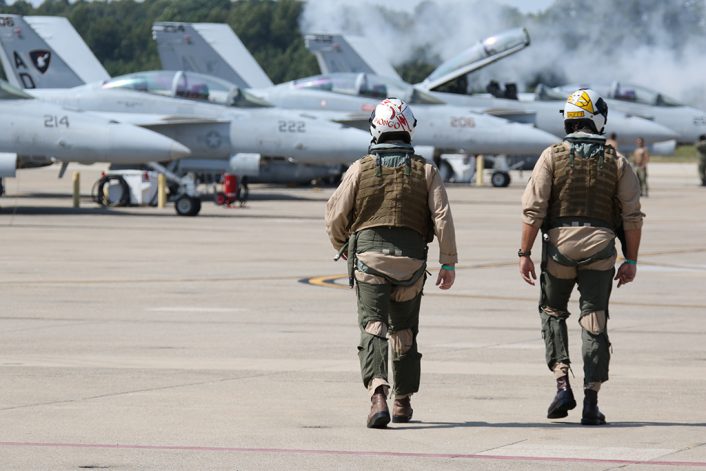
Demerly finally got lucky when two pilots stepped away from family members and ground crew, then cross over to the lineup of F/A-18s. “The shot came together so fast, and only lasted a second, I nearly missed it. The pilots are actually in the wrong place in my version, but it was as close as I could get using a real-world situation and not asking the pilots to re-walk the flight line and try to keep everyone else out of the way, which would have been impossible on an active flight line.”
The finished photo, shot using a Canon EOS 70D MkII with a Sigma 150-600mm f/5-6.3 DG OS HSM Sports Lens, looks similar to the movie stills from the iconic flight line scene in “Top Gun”.
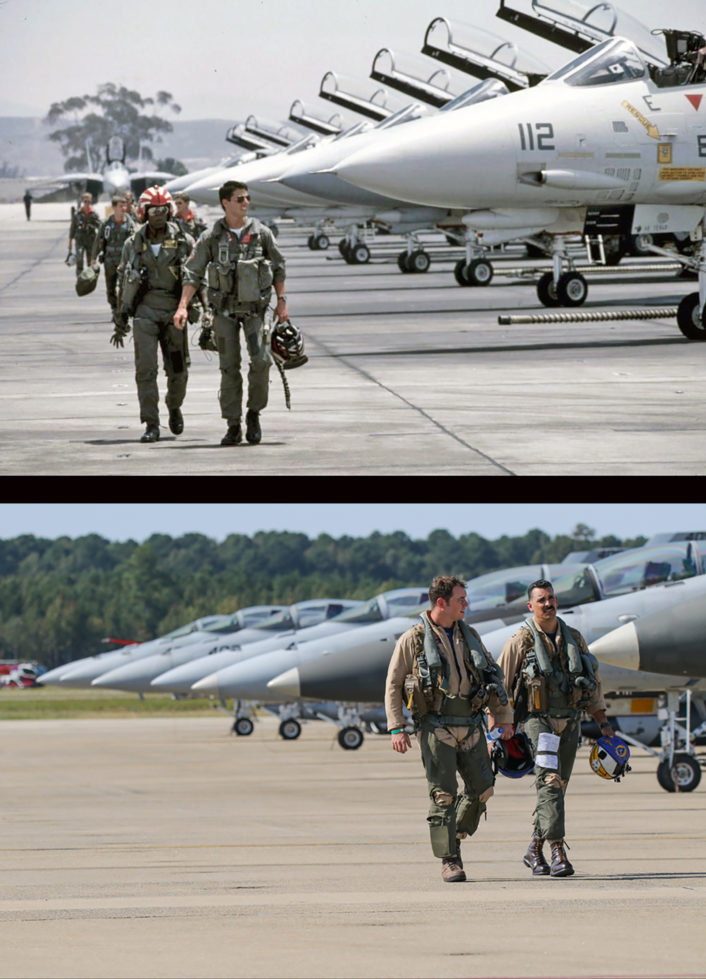
“It’s not an exact duplicate of the movie scene, but 33 years have passed since “Top Gun” was filmed and I think the similarities between the look of the movie, and from then to today, are much greater than the differences, so I was pretty happy with how it came out.”

